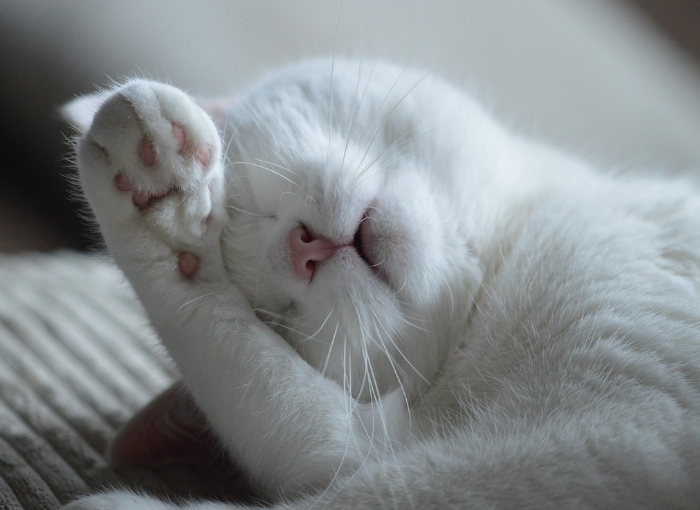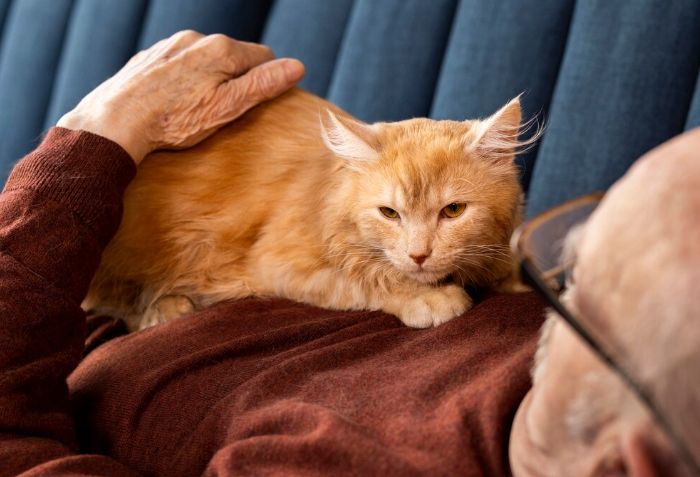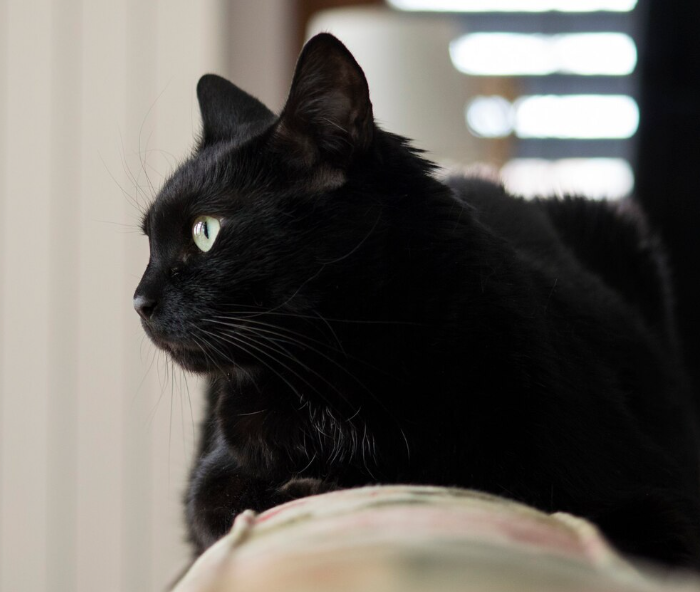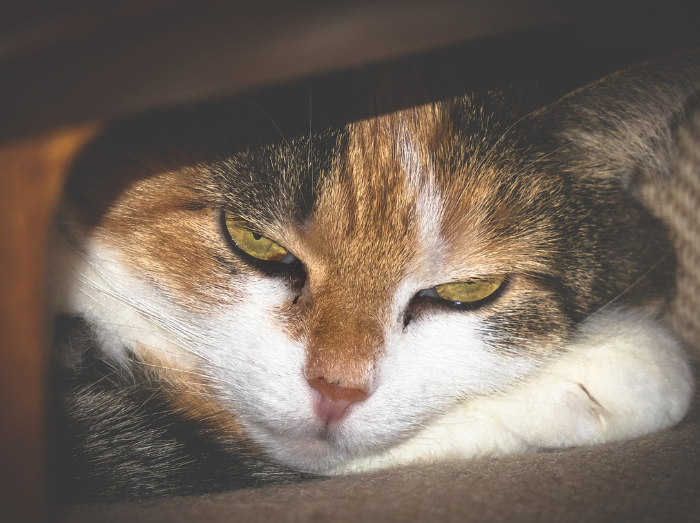2024-03-18
Fascinating, cuddly, wild, clingy, quirky, mysterious...there are many adjectives we can use to describe our amazing paw friends- cats! Despite all the eccentric behaviors cats may exhibit, they find their ways to get to their owners’ hearts and win their unconditional love!
Watching their most beloved paw friend sleep can make every cat owner melt...The joyful experience for cat owners becomes even greater if their cats have chosen to sleep by their side or on their chest or lap.
Let’s find out what the various sleeping positions of our feline friends mean and how to interpret them!

We will list several sleeping positions in this category that may indicate that your cat wants to be warm but also safe at the same time.
This a classic sleeping position for many cats. When curled up, our paw friends resemble a circle with their tails and paws put underneath the body.
This position, which is lovely to observe by cat owners, serves two purposes- it helps our feline friends keep body warmth and feel comfortable; it displays the instinct that cats have inherited from their wild ancestors- to keep themselves protected against potential predators.
When our beloved kitties sleep with their paws over their heads, this might indicate irritation to light or an attempt to block any tiny particles like dust. This position may also show the willingness of the cat to maintain their body warmth.
If you are the clingy one in the relationship “cat-human”, then your paw friend may want to show you that they need some time undisturbed. Our pets have their own needs for time alone to rest and relax, and as responsible owners, we should respect that.
We, cat owners, know that the famous love of cats for boxes and enclosed spaces is not just a myth but a real thing. It often happens that our fluffy friends prefer a generic box over expensive bedding or toys.
Going under the bed to prepare for sleeping and relaxing can be standard behavior for many cats, especially if it is their beloved human’s bed. It is quiet and dark and they can rest undisturbed.
However, there is also another explanation for this behavior. If sleeping under your bed is not common for your cat, but a behavior they started to exhibit suddenly, you should consult with a veterinarian.
Additionally, you should observe your cat and try to identify any signs of illness such as reduced appetite, lethargy, dehydration, or irritation. Looking for a quiet and dark space to sleep could indicate an underlying health issue, therefore you should take action as soon as possible!

One of the best experiences a cat owner could have is enjoying their purring fluffy friend gently sleeping on their chest. The warmth and fluffiness of our feline friends make us feel loved and cared for!
Sleeping over their owner’s body is a way for a cat to show their affection and trust. It could also be a way to “mark their territory”. This is especially valid for households with multiple cats, fighting for their owner’s attention.
If your paw friend enjoys sleeping right next to you, it indicates that they trust you. This is especially valid if they sleep with their back leaning on you.
This position shows that your cat is looking for your presence and feels comfortable and safe around you. It also allows your cat to keep an eye on the surroundings while keeping you both safe!
If there is some space between your kitty and yourself, do not get discouraged! Your feline friend still loves and shows they trust you! Some cats just need more personal space than others, especially while still young/adolescent.
All sleeping positions that are related to cats having their bellies exposed indicate their trust!
A cat would not show you their belly if they perceive you as a potential threat, as it is the most vulnerable part of the body.
Some cats enjoy lying on their back, others- on their side, while some feline friends like sleeping in an upright position. Although the third position looks very quirky, it enables cats to reach their bellies for grooming purposes and also stay alert to any changes in the environment or potential prey.
Sleeping on your feet is a way for your cat to show their affection to you, willingness to stay close, and also to keep you safe.
This position allows your cat to be alert to the environment and give an indication of a potential threat. It is believed that this position has also been evolutionarily inherited from their ancestors as a part of their survival instinct.
Curling between your legs clearly shows that your cat feels safe and comfortable around you, trusts you, and seeks your presence.
If your cat enjoys sleeping between your legs, you are likely to play the role of a safe enclosed space (maybe a box) that provides security and comfort at the same time.
Thinking of themselves as their cat’s box may not be ideal for some cat parents. However, we can assure you that this position displays your cat’s trust in you, so you should be happy.

Some sleeping positions indicate that our feline friends want to rest while not losing sight of the environment and potential prey or threat.
Baguette / Loaf Position
You may wonder what a position with such a hilarious name would look like…It is a common position in cats, that all of you might have already seen. It means that the cat is in a sitting position, upright, with their paws and tails tucked under the body. With some imagination, we could say their body looks like a loaf of bread.
When in this position, cats are usually relaxed and also have their vulnerable body areas protected and warm.
On the other hand, this position also enables them to react quickly to changes in the surroundings and engage their prey instinct if necessary.
Whether a cupboard, table, or another elevated spot at home, your paw friend may prefer to sleep there.
This position enables your cat to have a good view of all areas at home and not lose sight of potential prey while also being able to hide from potential predators.
Elevated spots are preferred sleeping areas of cats who have a strong prey drive.
If your paw friend enjoys spending time outdoors, this area might be a preferred sleeping area for them. This is also valid for cats who are curious and who actively explore their environment.
Sleeping in front of the door offers your cat a good opportunity to listen to noises and observe other animals, people, or objects from the outdoor world.
However, if the area outdoor is not cat-safe, you should take precautions and make sure your kitty will remain safe and healthy. Sometimes, it can be challenging to care for an overly inquisitive furry friend, so we need to be prepared!
Sleeping with their eyes half-closed could indicate that your cat is very alert and looks out for potential threats.
It is normal for cats to occasionally sleep that way, however, if it becomes a regular behavior, you may need to consult a veterinarian. Inspect your cat’s eyes for any discharge that might be present. Red eyes or eye discharge are symptoms of an infection and require medical assistance.
If you are wondering what this position could mean, simply think of a cat sleeping on a tree branch with their leg(s) hanging down.
Sleeping in a “monorail” position, usually means that a cat is sleeping on a narrow surface with their leg(s) hanging down.
This position helps your paw friend remain relaxed and comfortable, while also enabling them to be ready for action if needed!
It's a bird, It's a plane, it's Superman...or maybe it is your cat sleeping with all their legs stretched out as they are ready to fly!
However, having their legs extended enables your cat to get into position quickly and run after their prey!

Let’s clarify first that our pets are individuals, who exhibit their unique behaviors. What is valid for one pet is not automatically valid for another one. These positions should be taken into account, however, if your paw friend shows them occasionally while remaining energetic and in good health, there is nothing to worry about.
The food and water bowls are usually placed in a designated area at home, where our furry friends can eat and drink comfortably, without being disturbed. Having said that, your cat may simply like the separate area at home where their food and water supplies are, as this is a safe zone for them.
On the other hand, sleeping next to the water bowl may be a sign of dehydration, which requires immediate veterinarian consultation. If there is a health issue, additional symptoms like lack of appetite and fatigue are also likely to be present. You can do a quick test, by lightly pinching the skin between their shoulders. If the skin doesn’t promptly return to its normal position upon release, dehydration may be a concern.
Sleeping with their face down may be a simple technique to avoid light and have some quality time to rest and relax. It could also be one of your kitty’s behaviors, that show their unique personality.
On the other hand, it could also be a sign of illness. Similar to the case above, further symptoms are also likely to be present, such as lethargy and fatigue, decreased appetite, irritation, seeking places to hide, lack of coordination, weakness, dizziness, etc.
Depending on your cat’s general behavior, you should assess the situation and whether this is just a sleeping position or a sign of an underlying health condition. If you are not sure which is it, then you should consult a veterinarian. It is always better to be extra cautious than neglectful and putting your paw friend’s health at risk.
Some cats put a higher value on their personal space than others and prefer to sleep in more secluded areas.
Moreover, cats are likely to seek more private areas to hide, if they are stressed and anxious, e.g. due to changes in their environment, diet, extremely loud noises such as fireworks, etc.
In such cases, you should try removing the triggers in the surroundings (when possible) or at least make your cat’s personal space as comfortable and cozy, so they feel safe and relaxed. Do not force your furry friend to be around you or other people when they are feeling stressed. Respect their personal space and boundaries and show them you love them.
However, looking for hidden areas may indicate an underlying health condition, especially if this behavior is not common for your paw friend. Closely monitor them, and especially keep track of their water and food intake. If you notice your cat’s appetite has decreased or they do not drink enough water, don’t hesitate to reach out to a veterinarian. Additional symptoms of a medical condition are neglected grooming routine, lethargy, and labored breathing.
Sleeping in their litter box is not a common behavior in cats, so it may show that an illness is present.
Check your cat’s stool. If it’s too watery, your paw friend may have diarrhea. If there is blood in it, contact a veterinarian immediately.
Furthermore, cats sleeping in their litter boxes may suffer from joint issues like arthritis (especially seniors). By sleeping in the litter box, they ensure they have easy access to it.
A cognitive disorder may also be a cause of that behavior.
If you have any doubt that your cat may be dealing with a health illness, consult with a veterinarian immediately.
Sleeping in the same position is not an issue in itself. However, cats tend to change their sleeping position from time to time as a part of their survival instinct. This enables them to keep an eye on their surroundings and protect themselves from predators.
A feline friend who is suffering from a medical condition might be too weak to move and change their sleeping position.
Closely observe your paw companion and look out for any deviations from their standard behavior.
Cats are unique creatures who sometimes astonish us with their beauty and eccentric behaviors. As loving and responsible owners we should strive to provide them with the best possible living conditions and always be alert to any potential issues that might be present. This will help us take action promptly and ensure that our beloved purring friends will live a long and happy life!